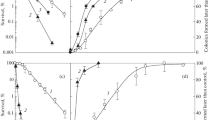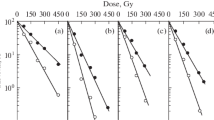Summary
In the present work we have investigated the possible interaction between Bleomycin (B) and UV light or hyperthermia (HT) in the induction of lethal events in diploid yeast populations in the stationary phase of growth. UV and B acting as single agents determine sigmoid survival curves. The combination of UV + B produces different degrees of sensitization depending on dose ranges. For [B] = 7.5 µg/ml combined with different UV fluences an exponential course is observed, suggesting overlapping lesion specificity of the involved repair pathways (excision and recombination). The hyperthermia plus Bleomycin treatment produces different degrees of inactivation depending on the sequences. Maximal inactivation effect was obtained for the sequence B + HT. In the case of HT + B ([B] > 7.5 µg/ml) the obtained sensitization is lower.
Similar content being viewed by others
References
Benathen A, Beam CA (1977) The genetic control of X-ray resistance in budding yeast cells. Radiat Res 69:99–116
Ben-Hur E, Elkind MM, Bronk BV (1974) Thermally enhanced radioresponse of cultured Chinese hamster: inhibition of repair of sublethal damage and enhancement of lethal damage. Radiat Res 38:38–51
Dietzel F (1975) Tumor und Temperatur. Urban und Schwarzenberg, München
Field SB, Andersen R (1982) Thermotolerance. A review of observations and possible mechanisms. J Natl Cancer Inst Mon 61:193–201
Game JC (1983) Radiation sensitive mutants and repair in yeast. In: Spencer JFT, Spencer DM, Smith ARW (eds) Yeast genetics. Springer Series in Molecular and Cell Biology. Springer, Berlin Heidelberg New York, pp 109–138
Jorritsma JBM, Burgman P, Kampinga HH, Konings AWT (1986) DNA polimerase activity in heat killing and hyperthermic radiosensitization of mammalian cells as observed after fractionated heat treatments. Radiat Res 105:307–319
Kampinga HH, Konings WT (1987) Inhibition of repair of X-ray-induced DNA damage by heat: the role of hyperthermic inhibition of DNA polymerase activity. Radiat Res 112:86–98
Keszenman D, Salvo VA, Nunes E (1990) Effects of Bleomycin on growth kinetics and survival ofSaccharomyces cerevisiae: a model of repair pathways (submitted for publication)
Kiefer J, Weyrather WK, Hlawica M (1976) Cellular radiation effects and hyperthermia, influence of exposure temperature on survival of diploid yeast irradiated under oxygenated and hypoxic conditions. Int J Radiat Biol 39:293–300
Latarjet R (1953) Un appareil simple pour le dosage des rayonnements ultraviolets émis par les lampes germicides. Ann Inst Pasteur 85:174
Landry J, Crete P, Lamarche S, Chrétien P (1988) Activation of Ca+2-dependent processes during heat shock: Role in cell thermoresistance. Radiat Res 113:426–436
Li GC, Cameron RB, Sapareto SA, Hahn GM (1982) Reinterpretation of Arrhenius analysis of cell inactivation by heat. NCI Monograph 61:111–113
McClanahan T, McEntee K (1986) DNA damage and heat shock dually regulate genes inSaccharomyces cerevisiae. Mol Cell Biol 6:90–96
Mitchel RE, Morrison DP (1982a) Heat-shock induction of ionizing radiation resistance inSaccharomyces cerevisiae, and correlation with stationary growth phase. Radiat Res 90:284–291
Mitchel RE, Morrison DP (1982b) Heat-shock induction of ionizing radiation resistance inSaccharomyces cerevisiae. Transient changes in growth cycle distribution and recombinational ability. Radiat Res 92:182–187
Mitchel RE, Morrison DP (1983) Heat shock induction of ultraviolet light resistance inSaccharomyces cerevisiae. Radiat Res 96:95–99
Moore CW (1978) Bleomycin-induced mutation and recombination inSaccharomyces cerevisiae. Mutat Res 58:41–49
Nielsen OS (1983) Influence of thermotolerance on the interaction between hyperthermia and radiation in L1 A2 cells in vitro. Int J Radiat Biol 43:665–673
Nunes E, Brum G, Candreva EC, Shenberg-Frascino AC (1984) Common repair pathways acting upon UV- and X-ray induced damage in diploid cells ofSaccharomyces cerevisiae. Int J Radiat Biol 45:593–606
Povirk L (1983) Bleomycin. In: Neidle S, Waring H (eds) Molecular aspects of anticancer drugs, vol 3. Byfleet. Macmillan, London
Povirk LF (1987) Bleomycin-induced mutagenesis in repackaged lambda phage: base substitution hotspots at the sequence C-G-C-C. Mutat Res 180:1–9
Povirk LF, Han Y-H, Steighner RJ (1989) Structure of Bleomycin-induced DNA double-strand breaks: predominance of blunt ends and single-base 5′ extensions. Biochemistry 28:5808–5814
Tomasovic SP, Sinha AK, Steck PA (1984) Rate of heating effects on stress protein synthesis. In: Overgaard J (ed) Hyperthermic oncology, vol 1. Taylor & Francis, London Philadelphia, pp 79–86
Umezawa H, Maeda K, Takeuchi T, Okam Y (1966) New antibiotic, Bleomycin A and B. J Antibiot (Tokyo) 19:200–209
Warters RL, Roti JL (1979) Excision of X-ray-induced thymine damage in chromatin from heated cells. Radiat Res 79:113–121
Wolters H, Kelholt D, Konings AWT (1987) Effect of hyperthermia on the repair of sublethal radiation damage in normal and membrane fatty acid substituted fibroblasts. Radiat Res 109:294–302
Author information
Authors and Affiliations
Rights and permissions
About this article
Cite this article
Barrios, E., Candreva, E.C. & Nunes, E. Survival of diploid yeast cells to Bleomycin in combination with UV-light or hyperthermia. Radiat Environ Biophys 30, 139–145 (1991). https://doi.org/10.1007/BF01219348
Received:
Accepted:
Issue Date:
DOI: https://doi.org/10.1007/BF01219348




